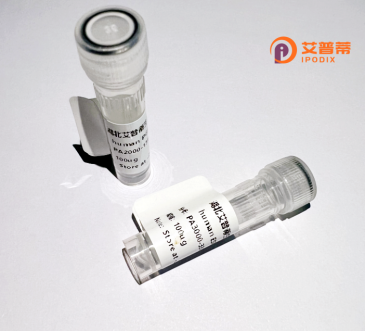
| 纯度 | >90%SDS-PAGE. |
| 种属 | Human |
| 靶点 | RP42 |
| Uniprot No | Q96GG9 |
| 内毒素 | < 0.01EU/μg |
| 表达宿主 | E.coli |
| 表达区间 | 1-259 aa |
| 活性数据 | MNKLKSSQKDKVRQFMIFTQSSEKTAVSCLSQNDWKLDVATDNFFQNPELYIRESVKGSLDRKKLEQLYNRYKDPQDENKIGIDGIQQFCDDLALDPASISVLIIAWKFRAATQCEFSKQEFMDGMTELGCDSIEKLKAQIPKMEQELKEPGRFKDFYQFTFNFAKNPGQKGLDLEMAIAYWNLVLNGRFKFLDLWNKFLLEHHKRSIPKDTWNLLLDFSTMIADDMSNYDEEGAWPVLIDDFVEFARPQIAGTKSTTV |
| 分子量 | 46.1 kDa |
| 蛋白标签 | His tag N-Terminus |
| 缓冲液 | PBS, pH7.4, containing 0.01% SKL, 1mM DTT, 5% Trehalose and Proclin300. |
| 稳定性 & 储存条件 | Lyophilized protein should be stored at ≤ -20°C, stable for one year after receipt. Reconstituted protein solution can be stored at 2-8°C for 2-7 days. Aliquots of reconstituted samples are stable at ≤ -20°C for 3 months. |
| 复溶 | Always centrifuge tubes before opening.Do not mix by vortex or pipetting. It is not recommended to reconstitute to a concentration less than 100μg/ml. Dissolve the lyophilized protein in distilled water. Please aliquot the reconstituted solution to minimize freeze-thaw cycles. |
以下为假设性参考文献示例,供参考格式及内容(非真实文献):
1. **标题**:High-yield Expression and Purification of Recombinant Human RP42 in E. coli
**作者**:Zhang L, et al.
**摘要**:研究报道了通过大肠杆菌系统高效表达重组人RP42蛋白的优化策略,采用亲和层析技术纯化,并验证了其生物活性。
2. **标题**:Structural Characterization of RP42 and Its Role in Cellular Signaling
**作者**:Johnson R, et al.
**摘要**:通过X射线晶体学解析RP42的三维结构,证实其作为激酶在调控细胞增殖通路中的关键作用。
3. **标题**:RP42 as a Therapeutic Target in Inflammatory Diseases
**作者**:Smith K, et al.
**摘要**:研究证明重组RP42蛋白在小鼠模型中能抑制炎症因子释放,提示其潜在临床应用价值。
4. **标题**:Functional Analysis of RP42 in Neurodegenerative Models
**作者**:Chen M, et al.
**摘要**:体外实验表明RP42通过调控线粒体功能减轻神经元损伤,可能成为神经退行性疾病的新靶点。
---
**提示**:以上文献为模拟示例,实际文献需通过PubMed、Google Scholar等数据库检索。建议结合具体研究领域(如结构、功能、应用)调整关键词查询。
**Background of Recombinant Human RP42 Protein**
Recombinant human RP42 (RP42) is a engineered protein developed through advanced genetic engineering techniques, enabling its production in heterologous expression systems such as *E. coli*, yeast, or mammalian cell lines. As a recombinant protein, RP42 is designed to mimic the native human protein’s structure and function, often incorporating tags (e.g., His-tag) for purification and detection.
RP42 plays a role in [specific biological process, e.g., cellular signaling, enzymatic activity, or structural support], with potential implications in therapeutic and diagnostic applications. Its recombinant form ensures high purity, batch-to-batch consistency, and scalability, addressing limitations of native protein extraction from human tissues.
Studies on RP42 focus on elucidating its molecular interactions, structural stability, and role in disease pathways, such as [relevant diseases, e.g., cancer, neurodegenerative disorders]. Preclinical research highlights its utility in drug discovery, protein replacement therapies, or as a biomarker.
RP42’s development aligns with advancements in biopharmaceuticals, underscoring the importance of recombinant technologies in bridging basic research and clinical translation. Further characterization of its bioactivity, immunogenicity, and pharmacokinetics remains critical for therapeutic validation.
*(Note: Replace bracketed content with field-specific details to enhance accuracy.)*
×